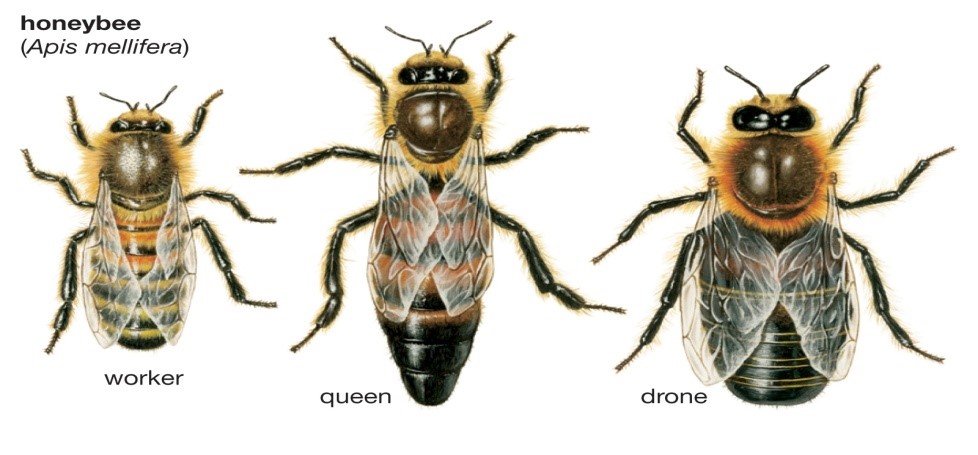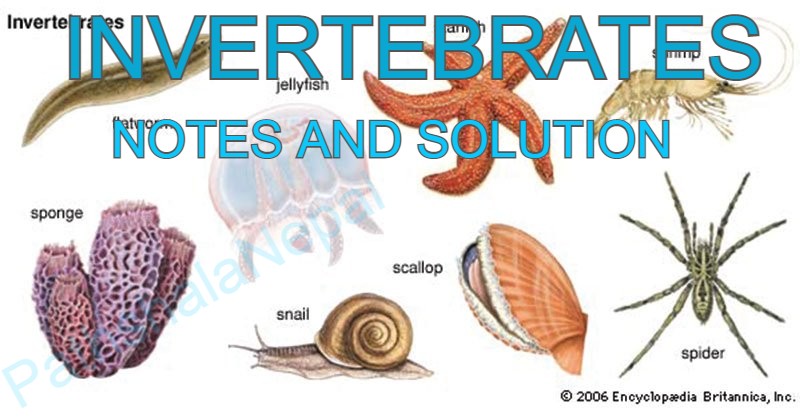Honey Bee
Honey bee is social and useful insect. They live in a colony in hive where all the individuals are of the same family, often the offspring are of same mother. They produce honey. There is division of labor.
Structure of Bee
The bodies of bee are divided into head, thorax and abdomen. The head consists of pair of antenna, a mouth part and a pair of compound eyes. The thorax consists of two pairs of wings and three pairs of jointed legs. The abdomen is elongated and segmented. The ovipositor of the queen bee through which it lays eggs is modified in the form of sting in workers.
Different types of bee in colony
There are three types of bee in a colony. They are:
- Queen bee: In a colony, there is only one queen bee which lays eggs. The queen bee is larger than drone and workers. The abdomen of queen is larger and slender whereas the head is smaller than drone and workers. The queen bee controls and guides the colony with the special type of odor release from its body.
A queen bee may live up to 2-5 years and spends all the time just by laying eggs. The queen bee is fed with royal jelly. (A special kind of highly nutritive protein rich, milky secretion produced by the workers in salivary gland).

The queen bee usually mates only once in her life and stores the sperms received from the drone in a sperm sac in her abdomen. When the store of sperms is used up, she mat continue to lay eggs but they are all unfertilized and will become drones. By this time, one of her daughters has been reared as a queen and is ready to take over the egg-laying.
2. Drone Bee: Drones are smaller than queen but larger than workers. They live for 4 to 5 weeks. Its body is black and hairy. They are fed by workers and their function is to fertilize the queen. It also keeps the hive warm. There are few hundreds of drones in a colony.
3. Worker Bee: The workers are the smallest bees in the colony they are the unfertile female bees whose reproductive organ do not work. They collect the food from outside the hive and store it, make the wax cells, give food to the queen, drones and larvae and also protect the bee hive from the enemies.
Life cycle of Bee
The life cycle of bee is completed in four distinct stages. They are egg, larvae, pupa and adult.
The queen bee emerges from the hive after 3 to5 days and mates with the males. The flight of the queen and drones outside the hive for mating is called nuptial flight or mating flight. After mating, the queen starts laying eggs after 2-3 days. Each egg is laid in one of the wax cells and hatches into tiny, white legless larvae. The larva feeds on substances deposited in cells by the workers. The larva grows, pupates in the cell, hatches as an adult bee and finally emerges from the cell into hive. Within 3-4 days the eggs are hatched into larvae and by 9 days are fully grown and ready to pupate. The workers put a capping over the cells at this time and the adult emerges by breaking the capping.
The duration of development of the three types of bees on favorable condition is:
| S.N | Types of Bee | Egg | Larva | Pupa | Adult |
| 1 | The queen | 3 days | 5.5 days | 7.5 days | 16 days |
| 2 | Drone | 3 days | 6 days | 14.5 days | 23.5 days |
| 3 | Worker | 3 days | 6 days | 12 days | 21 days |
Origin of three types of bees
The workers prepare three types of cells. Worker cells are about 5mm, drone cells are about 6mm and the queen cells are larger and made individually. The queen moves over a broad area laying eggs in any of the three cells placing her abdomen in the cell and depositing a single egg. The unfertilized eggs results into male or drone whereas the fertilized eggs results into queen and workers.
After hatching, all the larvae are fed by royal jelly. The larvae in the queen cells continue to feed on the royal jelly for the rest of their lives. The larvae in the drone and worker cell are fed in a mixture of dilute nectar and pollen.
Division of labor in the honey bee:
| S.N | Types and Age | Functions/Duties |
| 1 | The queen | - To lie eggs. - To control and guide the colony. |
| 2 | Drone | - To fertilize the queen. - To keep the hive warm. |
| 3 | Worker(1-3 days) | - To learn walking. - To give warmth to egg, larva and pupa. - To clean cells. |
| 4 | Worker(4-6 days) | - To feed mature larva worker. |
| 5 | Worker(7-11 days) | - To feed royal jelly to larvae below 3 days and the queen bee. |
| 6 | Worker(12-17 days) | - To secrete wax. - To build honey comb using wax. - To close the cell of the larvae and honey. |
| 7 | Worker(18-20 days) | - To protect the hive from enemies with their poison glands and sting. |
| 8 | Worker(21 days) | - To collect nectar from flowers. - To collect pollen grains, water, etc. |
Advantages of honey bee
- They produce honey. Honey is use for making medicines, for treating allergies, healing wounds, fighting infections, etc.
- They help in environmental balance.
- They help in pollination of different plants and increase productivity of crops.
Swarming
Swarming is a natural process in the life of a honey bee colony. Swarming occurs when a large group of honey bees leaves an established colony and flies off to establish a new colony, essentially creating two from one. Swarming is a natural method of propagation that occurs in response to crowding within the colony. Swarming usually occurs in late spring and early summer and begins in the warmer hours of the day. Honey bee swarms may contain several hundred to several thousand worker bees, a few drones and one queen. Swarming bees fly around briefly and then cluster on a tree limb, shrub or other object. Clusters usually remain stationary for an hour to a few days, depending on weather and the time needed to find a new nest site by scouting bees. When a suitable location for the new colony, such as a hollow tree, is found the cluster breaks up and flies to it. In the old hive, one new queen hatches out, mates and takes over the colony that is left.
Silkworm
Silkworm is a useful insect which produce silk fiber which is used to male silk cloths. Silk fiber is obtained from cocoon of silkworm.
The farming or rearing of the silkworm for the commercial production of silk fiber is called Seri-culture. In Nepal the commonly found species of silkworm are.
- Seri silkworm – Bombyx mori
- Eri silkworm - Attacus ricini
Seri silkworm feeds on mulberry leaves and eri silkworm feeds on castor leaves.
Structure of silk moth
The body if silkworm can be divided into three parts i.e. head, thorax and abdomen. The head bears a pair of compound eyes, a pair of feathery antenna and a sucking mouth part. The thorax bears two pairs of wing, three pairs of jointed legs and two pairs of spiracles for breathing. Similarly, the abdomen of silkworm is segmented with seven pairs of spiracles. The abdomen of female is larger than male.
Life cycle of silkworm
The life cycle of silkworm is completed in four stages. They are egg, larva, pupa and adult. After mating male dies and female dies after laying eggs.
Egg
After copulation, the female silkmoth lays about 300-400 eggs in cluster in the mulberry leaves. The silkworm produces the sticky secretion which protects egg from failing of the leaves. The eggs are round and yellowish white in colour. Under favorable condition at a temperature of 18°C-25°C the eggs are hatched into larva with on 10 to 12 days.
Larva
After 10 to 12 days, eggs are hatched into larva (caterpillar). The larva is creamy white and about 6mm long. They are voracious feeder and feeds on mulberry leaves. The body of larva contains head with biting and chewing mouth parts, the thorax is three-segmented with three pairs of true legs. The abdomen is ten segmented which contains five pairs of pseudo legs and dorsal anal horn on the 8th segment.
The larva moults for four times. The stage of a larva between two successive moulting is called instar. After fourth moulting that is in fifth instar, the caterpillar stops feeding and develops a pair of salivary gland which secrets a fluid. The liquid on exposure to the environment hardens and form silk thread. The silk fiber wrap around the body of caterpillar to form a pupal case called cocoon.
Pupa
The pupa stage of silkworm is inactive. It does not eat and move but metamorphosis takes place inside the cocoon and become an adult or imago. The imago secrets an alkaline fluid which moisten the cocoon in order to escape outside.
Adult
An adult silkworm is known as silk moth or imago which comes out the cocoon by tearing it. Imago dries its wings and flies away. Soon after emerging male and female adult silkworm mate.
Advantages of Seri-culture
- Seri-culture helps in production of silk fiber which is used to make different clothes.
- It can be practice with very low land holding.
- All the things used inn sericulture can be sold. The pupae are fed to animals. Similarly, spoilt cocoons can be used as food for fishes in fish farms.
Precautions during Seri-culture
- In the absence of mulberry leaves the eggs are kept in refrigerator or cold store below 18°C which prevents them from hatching.
- Clean and dry mulberry leaves should be fed to the larva of silkworm. If wet mulberry leaves are given they may die.
- In order to obtain silk fiber from the cocoon the pupa should be killed. The pupa is killed by threating the cocoon with hot water or placing it in hot oven. If the pupa is not killed inside the cocoon imago emerges out of the cocoon making the silk fiber useless.
- Few good quality cocoons are left for next generation.
Features of natural silk fiber
- It is durable, light and soft.
- It is long and elastic.
- It can be dyes into any desirable colors.
- Silk clothes can be worn on all climates.
- It can easily absorb sweat and water and can be dried easily.
This note contains Solved Questions, Formulas, and related notes.
Click Here to Read Original Version (Interactive Mode)

